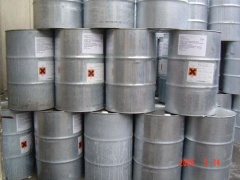Ethylbenzene
| Infobox on Ethylbenzene | |
|---|---|
| Example of Ethylbenzene |  |
| Facts | |
| Origin | - |
| Stowage factor (in m3/t) | - |
| Humidity / moisture | - |
| Ventilation | - |
| Risk factors | See text |
Ethylbenzene
Description / Application
Ethylbenzene is a clear, flammable liquid with a gasoline-like odour. It is naturally present in petroleum. Ethylbenzene is used mainly for the production of styrene. It is also used in the manufacture of dyes, rubber adhesives, paints and varnishes, as a constituent in asphalt and naptha, and it is added to gasoline up to 2 percent by weight. The odour threshold for ethylbenzene in water is reported to be between 0.3 and 0.14 parts per million (ppm); the reported odour threshold in air is 2.3 ppm.
Ethylbenzene is a volatile organic compound (VOC) in the ‘BTEX’ substance group which includes benzene, toluene, ethylbenzene and xylene. Ethylbenzene is a colourless liquid that smells similar to gasoline. It exists naturally in petroleum, and is also an industrial chemical with a variety of uses.
Ethylbenzene is an organic compound with the formula C6H5CH2CH3. This aromatic hydrocarbon is important in the petrochemical industry as an intermediate in the production of styrene, which in turn is used for making polystyrene, a common plastic material.
Ethylbenzene has been used as a solvent for aluminium bromide in the anhydrous electrodeposition of aluminium. Ethylbenzene is also an ingredient in some paints, and solvent grade xylene (xylol) is nearly always contaminated with a few percent of ethylbenzene.
Derivation is by heating benzene and ethylene in the presence of aluminium chloride with subsequent distillation, by fractionation directly from the mixed xylene stream in petroleum refining.











